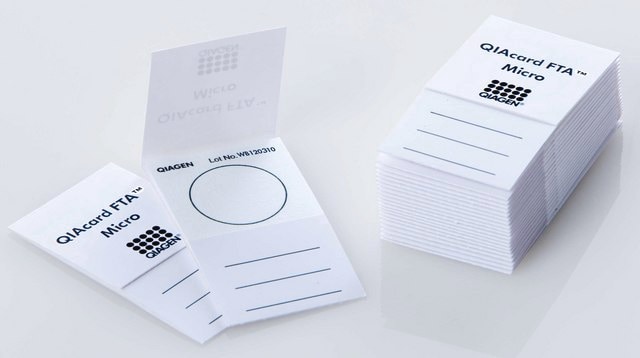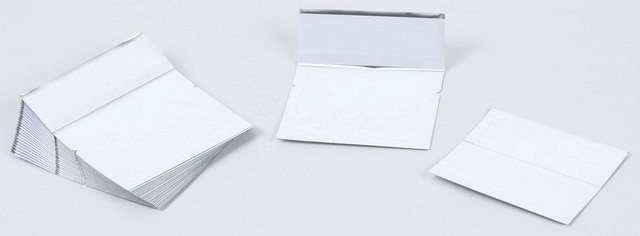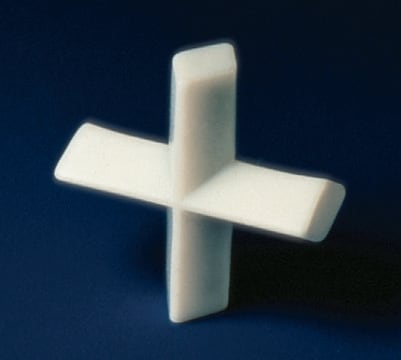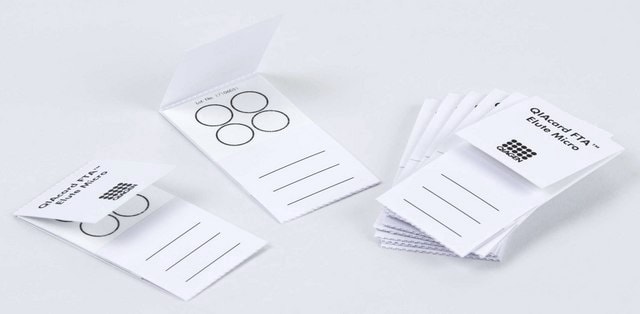WHAWB120311
QIAcard™ Indicating FTA™ Cards
micro, 1 sample area per card, pkg of 25 cards
Synonyme(s) :
QIAcard™ FTA™ Indicating Micro (25), Whatman FTA, Z747513
About This Item
Produits recommandés
Description
Indicating FTA Micro Card with 1 sample area per card, 125 μL maximum volume/sample area, 125 μL maximum total volume/card
Fabricant/nom de marque
Qiagen WB120311
Conditionnement
pkg of 25 cards
Vous recherchez des produits similaires ? Visite Guide de comparaison des produits
Catégories apparentées
Description générale
QIAcard™ FTA™ micro format with one spot area to collect, stabilize, process, transport, and archive colored samples such as blood. FTA™ technology enables cell lysis on contact, denatures proteins and immediate stabilization and protection of nucleic acids.
FTA™ micro cards utilize QIAcard™ FTA technology that simplifies the handling and processing of nucleic acids. FTA™ Cards contain chemicals that lyse cells, denature proteins and protect nucleic acids from nucleases, oxidation and UV damage. FTA™ cards rapidly inactivate organisms, including blood-borne pathogens, and prevent the growth of bacteria and other microorganisms.
Convenient for protocols that require different locations for testing and archiving samples. Different samples can be processed independently.
Caractéristiques et avantages
- Includes a pink dye that turns white when a colorless sample is applied.
- One sample area for application of up to 125 μl sample volume per card.
- Simply apply your sample to the FTA™ Card. Cell membranes and organelles are lysed and the released nucleic acids are entrapped in the fibers of the matrix. The nucleic acids remain immobilized and are preserved for transport, immediate processing or long-term room temperature storage.
- Since captured nucleic acids are preserved, FTA™ Cards facilitate sample collection in remote locations and simplify sample transport.
- Ship your samples back to the laboratory without expensive special handling or dry ice and process at your convenience.
- FTA™ Cards can be used with virtually any sample type: Blood, Cultured cells, Buccal cells, Plasmids, and Solid tissue.
- Captured nucleic acids are ready for purification when you are. Just take a punch from the FTA™ Card, wash with FTA™ Purification Reagent and rinse with TE-1 (10 mM Tris-HCI, 0.1 mM EDTA, pH 8) buffer. DNA on the washed punch is ready to use in applications such as PCR, SNP analysis, and real-time PCR. Since PCR products remain in solution, the punch can be used for multiple amplifications.
Autres remarques
Field of Use : For internal research use only
Informations légales
Certificats d'analyse (COA)
Recherchez un Certificats d'analyse (COA) en saisissant le numéro de lot du produit. Les numéros de lot figurent sur l'étiquette du produit après les mots "Lot" ou "Batch".
Déjà en possession de ce produit ?
Retrouvez la documentation relative aux produits que vous avez récemment achetés dans la Bibliothèque de documents.
Les clients ont également consulté
Articles
Description of common problems that can occur during genomic DNA preparation
This article describes the evaluation of Whatman FTA cards from Cytiva for their ability to collect, store, and isolate high-quality RNA from a variety of crude biological samples.
Polymerase chain reaction (PCR) is a technique that results in exponential amplification of a target DNA sequence.
Protocoles
This page shows genomic DNA purification from sample on FTA elute from Cytiva.
This study examined the yield and quality of DNA from samples applied to Whatman FTA cards, using five common methods of DNA extraction.
A number of options are available for sample collection, transport, archiving, and DNA purification.
Spectrophotometry can be used to estimate DNA or RNA concentration and to analyze the purity of the preparation.
Notre équipe de scientifiques dispose d'une expérience dans tous les secteurs de la recherche, notamment en sciences de la vie, science des matériaux, synthèse chimique, chromatographie, analyse et dans de nombreux autres domaines..
Contacter notre Service technique












